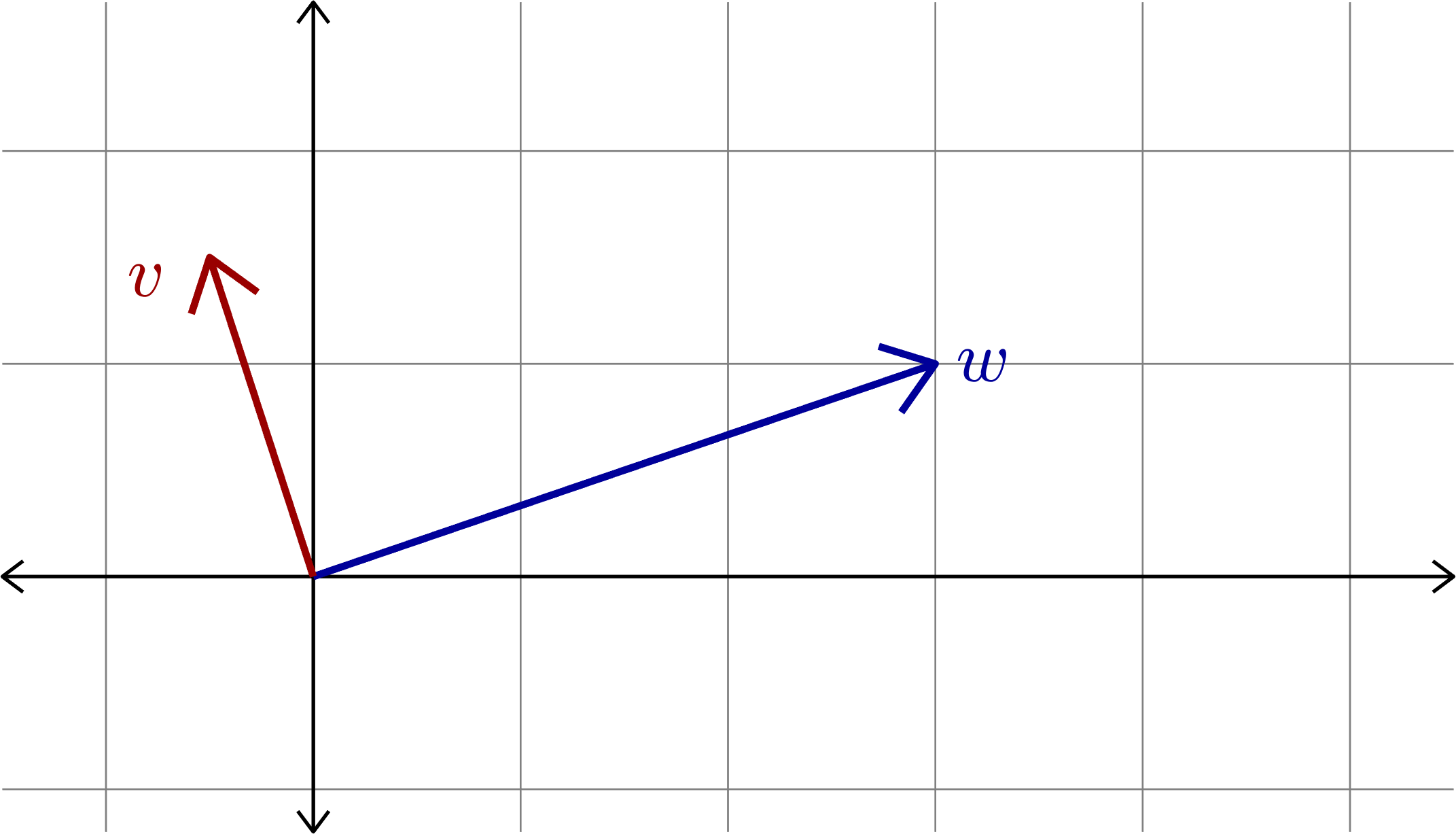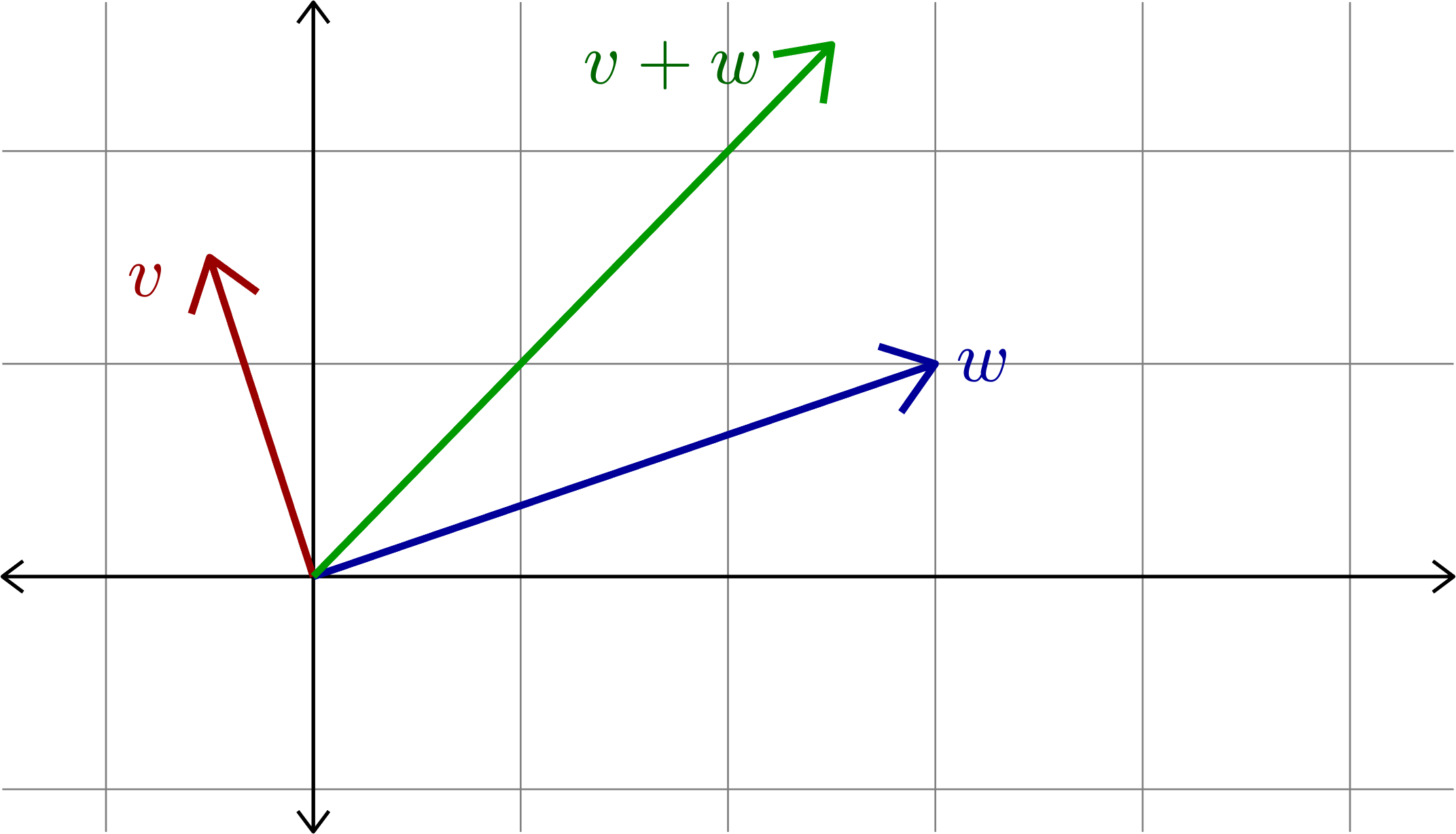Day 17:
Orthogonal projections and Gram-Schmidt
Norms
Definition. Given an inner product space \(V\) and a vector \(v\in V\), then norm of \(v\) is the number
\[\|v\| = \sqrt{\langle v,v\rangle}.\]
Example. Consider the inner product space \(\mathbb{P}_{2}\) with the inner product given previously. If \(f(x) = x\), then
\[\|f(x)\|= \sqrt{\int_{0}^{1}x^2\, dx} = \sqrt{\frac{1}{3}}.\]
Example. Let \(x=[1\ \ -2]^{\top}\in\mathbb{R}^{2}\), then
\[\|x\| = \sqrt{1^2+(-2)^2} = \sqrt{5}.\]
Orthonormal bases
Definition. Let \(V\) be an inner product space. A set \(\mathcal{B}=\{v_{1},\ldots,v_{k}\}\subset V\) is called an orthonormal basis for \(V\) if \(\mathcal{B}\) is a basis for \(V\) and for \(i,j\in\{1,2,\ldots,k\}\)
\[\langle v_{i},v_{j}\rangle = \begin{cases} 1 & i=j,\\ 0 & i\neq j.\end{cases}\]
Example. The standard basis \(\{e_{1},e_{2},\ldots,e_{n}\}\) is an orthonormal basis for \(\mathbb{R}^{n}\).
Example.
The set \[\left\{\frac{1}{2}\left[\begin{array}{r} 1\\ 1\\ 1\\ 1\end{array}\right],\frac{1}{2}\left[\begin{array}{r} 1\\ -1\\ 1\\ -1\end{array}\right],\frac{1}{2}\left[\begin{array}{r} 1\\ 1\\ -1\\ -1\end{array}\right],\frac{1}{2}\left[\begin{array}{r} 1\\ -1\\ -1\\ 1\end{array}\right]\right\}\]
is an orthonormal basis for \(\mathbb{R}^{4}\).
Orthonormal bases
Example. In \(\mathbb{P}_{2}\) with inner product
\[\langle f(x),g(x)\rangle = \int_{0}^{1} f(x)g(x)\,dx\]
the set \(\{1,x,x^2\}\) is a basis, but it is not an orthonormal basis. Indeed, note that
\[\langle 1,x\rangle = \int_{0}^{1}x\,dx = \frac{1}{2}.\]
Example. In \(\mathbb{P}_{2}\) with inner product
\[\langle f(x),g(x)\rangle = \int_{-1}^{1} f(x)g(x)\,dx\]
the set \[\left\{\frac{\sqrt{2}}{2},\frac{\sqrt{6}}{2}x,\frac{\sqrt{10}}{4}(3x^2-1)\right\}\] is an orthonormal basis. (Check it yourself)
Orthogonal bases
In some cases it is more convenient not to use a basis where the norms of the vectors are not all \(1\).
Definition. Given a vector \(v\) in an inner product space \(V\), the vector \(v\) is called normalized if \(\|v\|=1\). Given \(v\neq 0\), the vector \(\frac{v}{\|v\|}\) is called the normalized vector in the direction of \(v\).
Definition. If \(V\) is an inner product space, and \(\mathcal{B}:=\{v_{1},v_{2},\ldots,v_{k}\}\subset V\), then we call \(\mathcal{B}\) an orthogonal basis for \(V\) if \(\mathcal{B}\) is a basis for \(V\) and \[\left\{\frac{v_{1}}{\|v_{1}\|}\frac{v_{2}}{\|v_{2}\|},\ldots,\frac{v_{k}}{\|v_{k}\|}\right\}\] is an orthonormal basis for \(V\).
Example. In \(\mathbb{P}_{2}\) with inner product with the inner product from the last example, the set \(\left\{1,x,3x^2-1\right\}\) is an orthogonal basis for \(\mathbb{P}_{2}\).
Orthonormal bases
Let \(V\) be a subspace of \(\R^{n}\). Assume \(\mathcal{B}=\{v_{1},\ldots,v_{k}\}\) is an orthonormal basis for \(V\). Define the matrix
\[A = \begin{bmatrix} v_{1} & v_{2} & \cdots & v_{k}\end{bmatrix}.\]
Let \(v\in V.\) Since \(\mathcal{B}\) is a basis, there are unique scalars \(\alpha_{1},\ldots,\alpha_{k}\) such that
\[v = \alpha_{1}v_{1} + \alpha_{2}v_{2} + \cdots +\alpha_{k}v_{k}.\]
However, if we take a dot product:
\(v_{i}\cdot v = v_{i}\cdot\big(\alpha_{1}v_{1} + \alpha_{2}v_{2} + \cdots +\alpha_{k}v_{k}\big)\)
\(= \alpha_{1}(v_{i}\cdot v_{1}) + \alpha_{2}(v_{i}\cdot v_{2}) + \cdots +\alpha_{k}(v_{i}\cdot v_{k}) = \alpha_{i}\)
Hence, the coefficient on \(v_{i}\) must be the scalar \(v_{i}\cdot v\). That is,
\[v = \sum_{i=1}^{k}(v_{i}\cdot v) v_{i} = \sum_{i=1}^{k}(v_{i}^{\top}v) v_{i}= AA^{\top}v.\]
Orthonormal bases
Additionally, for any \(v\in V\) we have
\[ = \left(\sum_{i=1}^{k} (v_{i}\cdot v) v_{i}^{\top}\right)\left(\sum_{j=1}^{k} (v_{j}\cdot v) v_{j}\right)\]
\[ =\sum_{i=1}^{k}\sum_{j=1}^{k} (v_{i}\cdot v) v_{i}^{\top}(v_{j}\cdot v) v_{j}\]
\[ =\sum_{i=1}^{k}|v_{i}\cdot v|^2\]
\[ =\sum_{i=1}^{k}\sum_{j=1}^{k} (v_{i}\cdot v)(v_{j}\cdot v) v_{i}^{\top} v_{j}\]
\[\|v\|^{2} = v^{\top}v= \left(\sum_{i=1}^{k} (v_{i}\cdot v) v_{i}\right)^{\top}\left(\sum_{j=1}^{k} (v_{j}\cdot v) v_{j}\right)\]
Another way to state this is \(\|v\| = \|A^{\top}v\|\).
Orthonormal bases
Additionally, for any \(v\in V\) we have
\[ = \left(\sum_{i=1}^{k} (v_{i}\cdot v) v_{i}^{\top}\right)\left(\sum_{j=1}^{k} (v_{j}\cdot v) v_{j}\right)\]
\[ =\sum_{i=1}^{k}\sum_{j=1}^{k} (v_{i}\cdot v) v_{i}^{\top}(v_{j}\cdot v) v_{j}\]
\[ =\sum_{i=1}^{k}|v_{i}\cdot v|^2\]
\[ =\sum_{i=1}^{k}\sum_{j=1}^{k} (v_{i}\cdot v)(v_{j}\cdot v) v_{i}^{\top} v_{j}\]
\[\|v\|^{2} = v^{\top}v= \left(\sum_{i=1}^{k} (v_{i}\cdot v) v_{i}\right)^{\top}\left(\sum_{j=1}^{k} (v_{j}\cdot v) v_{j}\right)\]
Another way to state this is \(\|v\| = \|A^{\top}v\|\).
Theorems about norms and inner products
Theorem (The polarization identity). If \(V\) is an inner product space, and \(v,w\in V\), then
\[\|v+w\|^{2} = \|v\|^{2}+2\langle v,w\rangle + \|w\|^{2}\]
and thus
\[\langle v,w\rangle = \frac{1}{2}\left(\|v+w\|^2 - \|v\|^{2} - \|w\|^{2}\right).\]
Proof. Using the properties of an inner product we have
\[\|v+w\|^{2} = \langle v+w,v+w\rangle = \langle v,v+w\rangle + \langle w,v+w\rangle\]
\[=\langle v,v\rangle + \langle v,w\rangle + \langle w,v\rangle + \langle w,w\rangle\]
\[=\|v\|^2 + \langle v,w\rangle + \langle v,w\rangle + \|w\|^2\]
\[=\|v\|^2 + 2\langle v,w\rangle + \|w\|^2.\]
The other conclusion follows by rearranging the first equality. \(\Box\)
Theorem (the Pythagorean Theorem). Suppose \(V\) is an inner product space and \(v,w\in V\). Then, \(\langle v,w\rangle= 0\) if and only if
\[\|v\|^{2} + \|w\|^2 = \|v+w\|^2.\]
Proof. By the polarization identity \[\|v+w\|^{2} = \|v\|^{2}+2\langle v,w\rangle + \|w\|^{2}\]
\(\Box\)



Theorem (the Cauchy-Schwarz inequality). Suppose \(V\) is an inner product space. If \(v,w\in V\), then
\[|\langle v,w\rangle|\leq \|v\|\|w\|.\]
Moreover, if equality occurs, then \(v\) and \(w\) are dependent.
Proof. If \(v=0\) then both sides of the inequality are zero, hence we are done. Moreover, note that \(v\) and \(w\) are dependent.
Suppose \(v\neq 0\). Define the scalar \(c = \frac{\langle v,w\rangle}{\|v\|^2}\), and compute
\[ \]
\[ = \|w\|^{2} - 2\frac{\langle v,w\rangle}{\|v\|^2}\langle w,v\rangle + \frac{|\langle v,w\rangle|^2}{\|v\|^4}\|v\|^{2} = \|w\|^{2} - \frac{|\langle v,w\rangle|^2}{\|v\|^2}\]
\[0 \leq \|w-cv\|^{2} = \|w\|^{2} - 2\langle w,cv\rangle + \|cv\|^{2} = \|w\|^{2} - 2c\langle w,v\rangle + c^2\|v\|^{2}\]
Rearranging this inequality we have
\[\frac{|\langle v,w\rangle|^2}{\|v\|^2}\leq \|w\|^{2}.\]
Note, if this inequality is actually equality, then we have \(\|w-cv\|=0\), that is \(w-cv=0\). This implies \(v\) and \(w\) are dependent. \(\Box\)
Theorem (the Triangle inequality). Suppose \(V\) is an inner product space. If \(v,w\in V\), then
\[\|v+w\|\leq \|v\|+\|w\|.\]
Moreover, if equality occurs, then \(v\) and \(w\) are dependent.
Proof. First, note that \(\langle v,w\rangle\leq |\langle v,w\rangle|\). Using the polarization identity and the Cauchy-Schwarz inequality we have
\[\leq \|v\|^{2} + 2\|v\|\|w\| + \|w\|^{2} = \big(\|v\|+\|w\|\big)^{2}.\]
\[\leq \|v\|^{2} + 2|\langle v,w\rangle| + \|w\|^{2}.\]
\[\|v+w\|^{2} = \|v\|^{2}+2\langle v,w\rangle + \|w\|^{2}\]
Note that if \(\|v+w\|=\|v\|+\|w\|\), then we must have
\[\|v\|^{2} + 2|\langle v,w\rangle| + \|w\|^{2} = \|v\|^{2} + 2\|v\|\|w\| + \|w\|^{2}\]
and thus \(|\langle v,w\rangle|=\|v\|\|w\|\). By the Cauchy-Schwarz inequality, this implies \(v\) and \(w\) are dependent. \(\Box\)
Quiz.
- For \(x,y\in\mathbb{R}^{2}\) such that \(\langle x,y\rangle = 2\) it _______________ holds that \(\|x\|=\|y\|=1\).
- For \(x,y\in\mathbb{R}^{2}\) such that \(\langle x,y\rangle = 0\) it _______________ holds that \(|\langle x,y\rangle| = \|x\|\|y\|\).
- For normalized \(x,y\in\mathbb{R}^{2}\) such that \(\|x+y\|^{2} = \|x\|^{2} + \|y\|^{2}\) it _______________ holds that \(|\langle x,y\rangle| = \|x\|\|y\|\).
- For nonzero vectors \(x,y\in\mathbb{R}^{n}\) it _______________ holds that \(\|x+y\|^{2} = \|x\|^{2}+\|y\|^{2}\) and \(\|x+y\|=\|x\|+\|y\|\).
never
sometimes
never
never
Linear Algebra Day 17
By John Jasper
Linear Algebra Day 17
- 885



